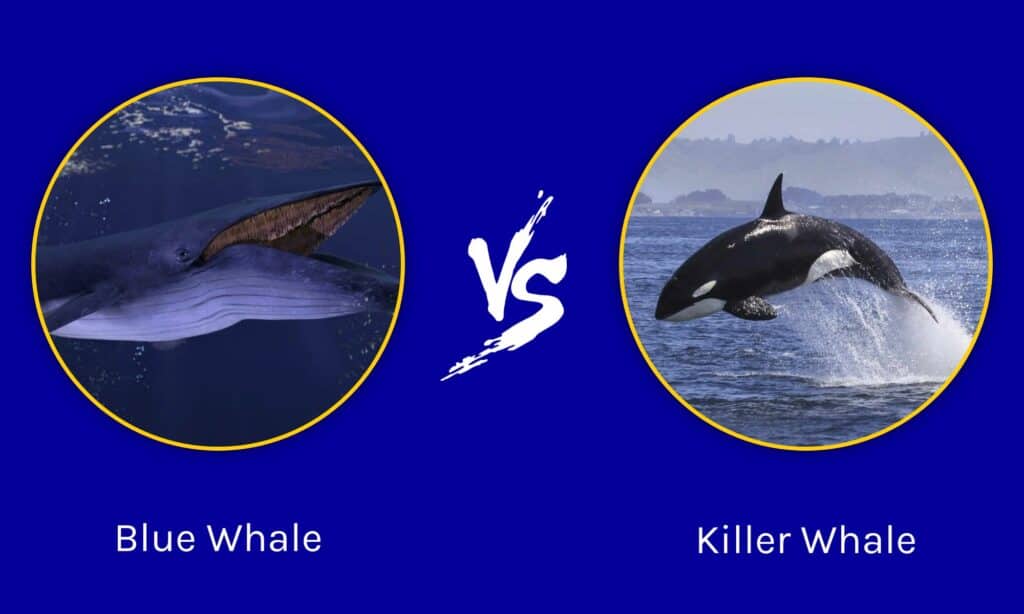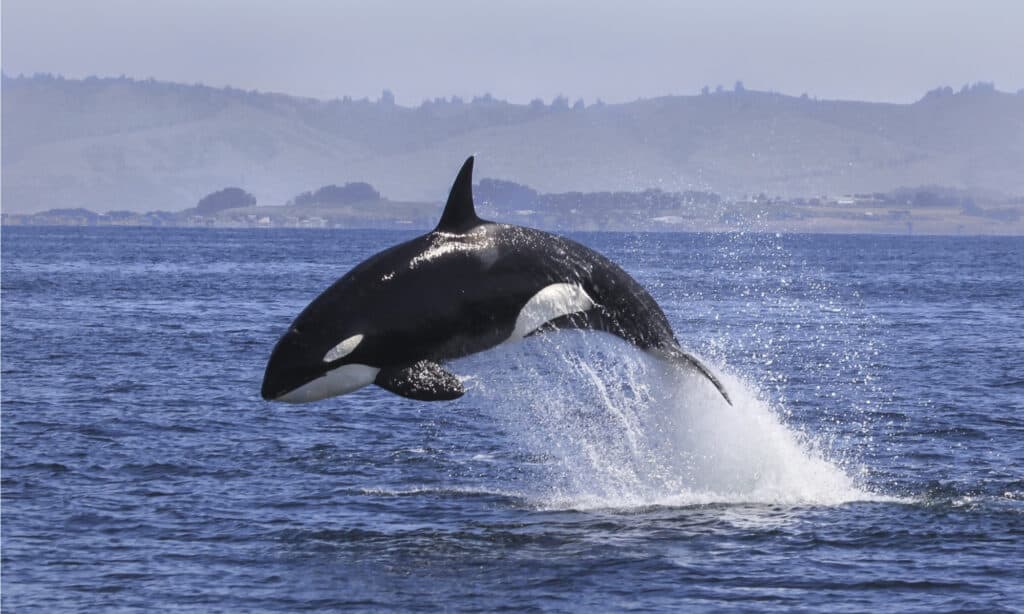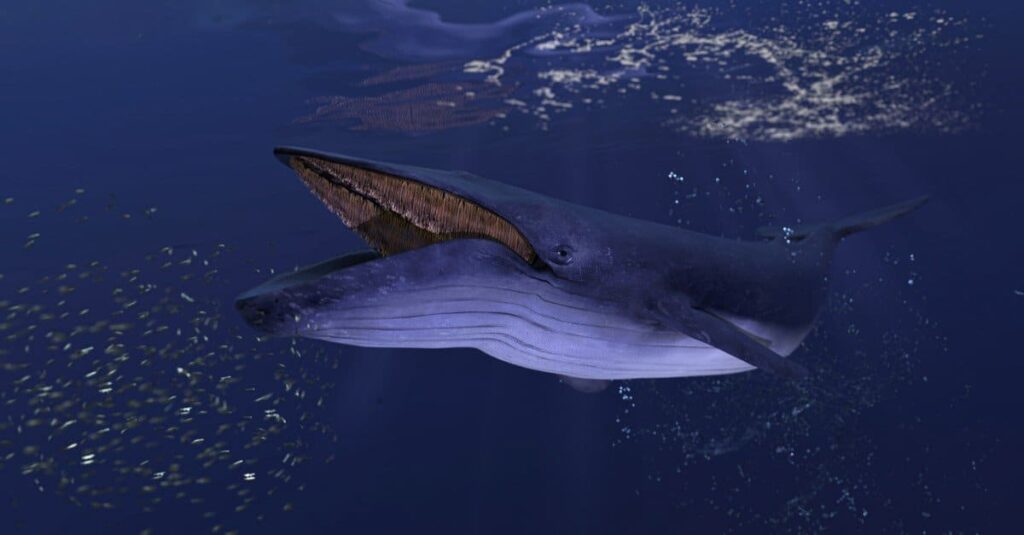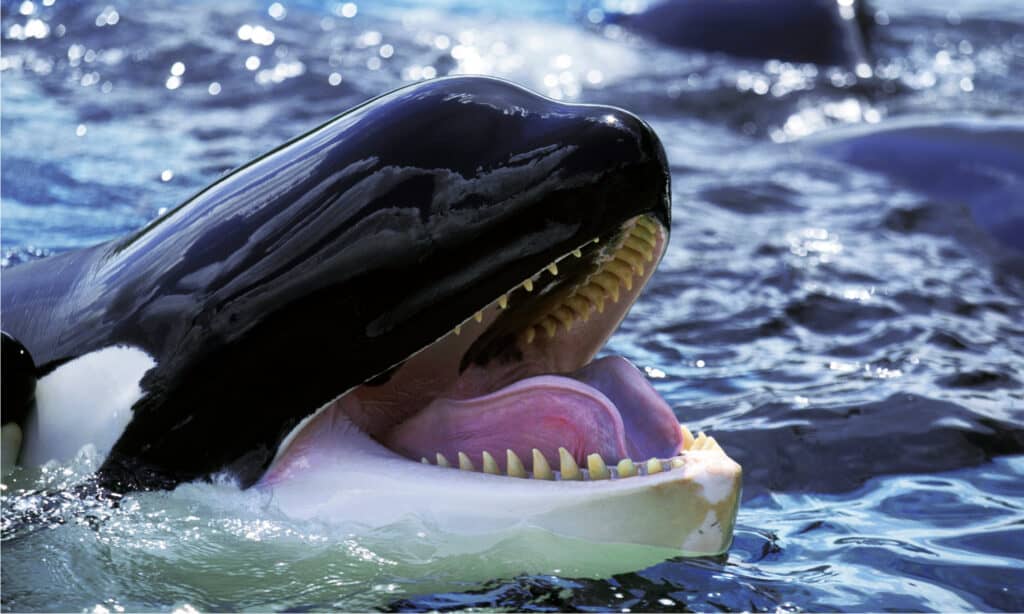Blue whales and killer whales (orcas) are some of the largest creatures in the ocean and some of the most famous. These intelligent animals are truly amazing and share some distinct similarities. Still, there are some major differences that can help us understand what makes them unique. Let’s discover the differences between a Blue Whale vs Killer Whale!
Comparing a Blue Whale and a Killer Whale

| Blue whale | Killer whale (orca) | |
|---|---|---|
| Size | Length: 82.5ft – 100ft Weight: 100 – 160 tons | Length: 20-26 feet long Weight: 6+ tons |
| Appearance | Long, slender whales. Large mouths. Blue-gray in color across the entire body. | Dolphin-like in appearance. Distinctive black and white pigmentation. |
| Diet | Krill, Crustaceans, Small Fish | Apex predator. Fish, sharks, rays, mammals, whales, seals, and almost anything else. |
| Teeth | Baleen whale. | Toothed whale. |
| Distribution | Nearly everywhere except far northern waters. | Worldwide in arctic and tropical waters. |
| Population | Less than 20,000 | 50,000+ |
The 6 main differences between a blue whale and a killer whale
The main differences between a blue whale and a killer whale are that blue whales are larger, feed using baleen, and don’t live in the furthest northern waters. Killer whales are smaller, are predatory and have teeth, and live throughout the world’s oceans.
Blue whales and killer whales are somewhat similar creatures, although nobody is likely to confuse the two. Both animals are air-breathing mammals and belong to the whale family, although orcas have a further classification as members of the dolphin family.
When it comes to size, the blue whale far surpasses the orca and any creature to have ever lived, for that matter. Still, orcas aren’t small creatures by any means and are some of the ocean’s most feared predators. Blue whales are filter feeders that use keratinized bristles to catch small ocean life, while orcas feed on fish and mammals.
Blue whales look like many other baleen whales, just larger. They are generally slender animals designed for long-distance travel through the ocean. Killer whales are significantly smaller and have the famous black and white patterns that somewhat resemble that of a panda. You can find blue whales nearly everywhere besides the furthest regions in the north. Orcas are found everywhere blue whales are found, plus in the far northern regions.
Let’s explore some of the other differences between these two animals in more detail below!
Blue Whale vs Killer Whale: Size

Blue whales are the largest creatures to have ever lived.
©Atomic Roderick/Shutterstock.com
When it comes to sheer size, nothing compares to the blue whale. Blue whales aren’t just large; they are the largest creatures to have ever lived on earth. The average blue whale measures 82.5ft – 100ft long and weighs 100 – 160 tons.
Killer whales are large but simply don’t compare to the kings of the ocean. Orcas are generally 20-26 feet long and weigh upwards of 6 tons. It would take 20-30 killer whales to equal the weight of a full-grown blue whale, for reference.
Blue Whale vs Killer Whale: Appearance

Orcas are shorter, smaller, and have black and white skin.
©Tory Kallman/Shutterstock.com
The blue whale is a creature designed for long-distance ocean travel. As such, it has a long, streamlined body perfect for minimal energy use. It has thick skin that appears gray-blue, giving it its name. Additionally, blue whales have pleats on their throat that allow them to open their mouths wider when eating.
Killer whales have some of the most distinct appearances in all of the ocean. They are large dolphin-like creatures with stubby snouts, visible teeth, and a long dorsal fin. The most notable identifier of an orca is their pattern, a black and white splotched design that somewhat looks like a panda.
Blue Whale vs Killer Whale: Diet

Blue whales eat krill and small crustaceans.
©bekirevren/Shutterstock.com
The largest creatures on earth eat some of the smallest creatures in the ocean! Blue whales are filter feeders that gulp large amounts of water and push it through special teeth known as “baleen.” Small creatures get stuck in the baleen and are swallowed. A blue whale’s preferred foods are krill, crustaceans, and even small fish, although the fish are usually accidentally caught.
Killer whales are the apex predators in the entire ocean. They eat turtles, large fish, small fish, seals, sea lions, sharks, dolphins, whales, and more. When hunting as a pack, orcas can take down whales that are significantly larger than they are, even the occasional blue whale juvenile.
Blue Whale vs Killer Whale: Teeth

Orcas have distinct teeth.
©slowmotiongli/Shutterstock.com
Although both creatures are whales, they are differentiated by their teeth. Blue whales don’t have teeth. Instead, they have baleen, classifying them as baleen whales. Baleen whales gulp water and filter food through their filter-like structures in their mouths. Other baleen whales include humpback whales, gray whales, and fin whales.
Killer whales are known as “toothed whales.” Toothed whales are predators that kill large prey. Other toothed whales include sperm whales and beaked whales.
Blue Whale vs Killer Whale: Distribution

Blue whales live everywhere but in the far northern oceans.
©Andrew Sutton/Shutterstock.com
You can find blue whales in nearly any ocean in the world, although they prefer cooler waters as a general rule. The only places that blue whales don’t venture are the frozen regions in the far north, past the southern tip of Greenland.
Killer whales are more widely distributed than blue whales and can be found in every ocean in the world, including the far northern regions.
Blue Whale vs Killer Whale: Population

There are about 50,000 orcas left.
©slowmotiongli/Shutterstock.com
Current population estimates for blue whales place numbers at around 20,000 individuals worldwide. There are varying population groups that generally stick to certain regions within the oceans. Blue whales are a threatened species that are at risk.
Killer whale population estimates currently place them upwards of 50,000 individuals. Although there are more orcas around than blue whales, orcas are still at risk, mostly due to human threats.
The photo featured at the top of this post is © slowmotiongli/Shutterstock.com
Thank you for reading! Have some feedback for us? Contact the AZ Animals editorial team.






